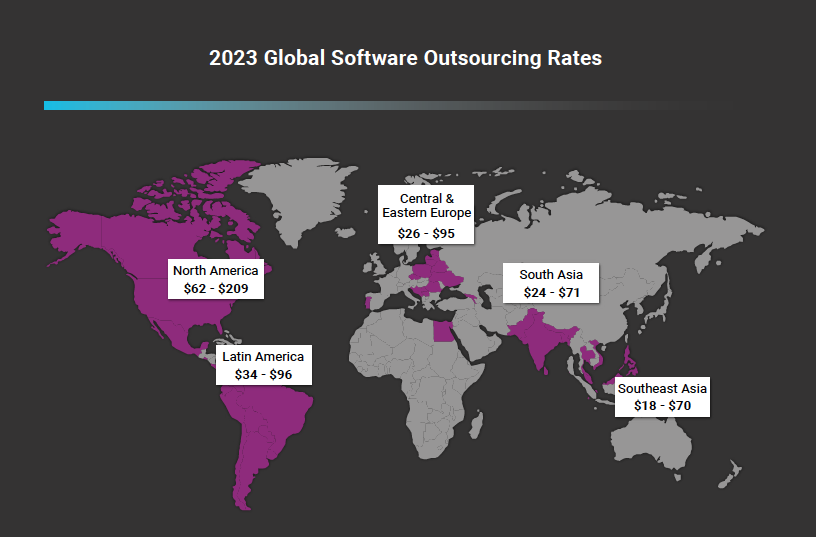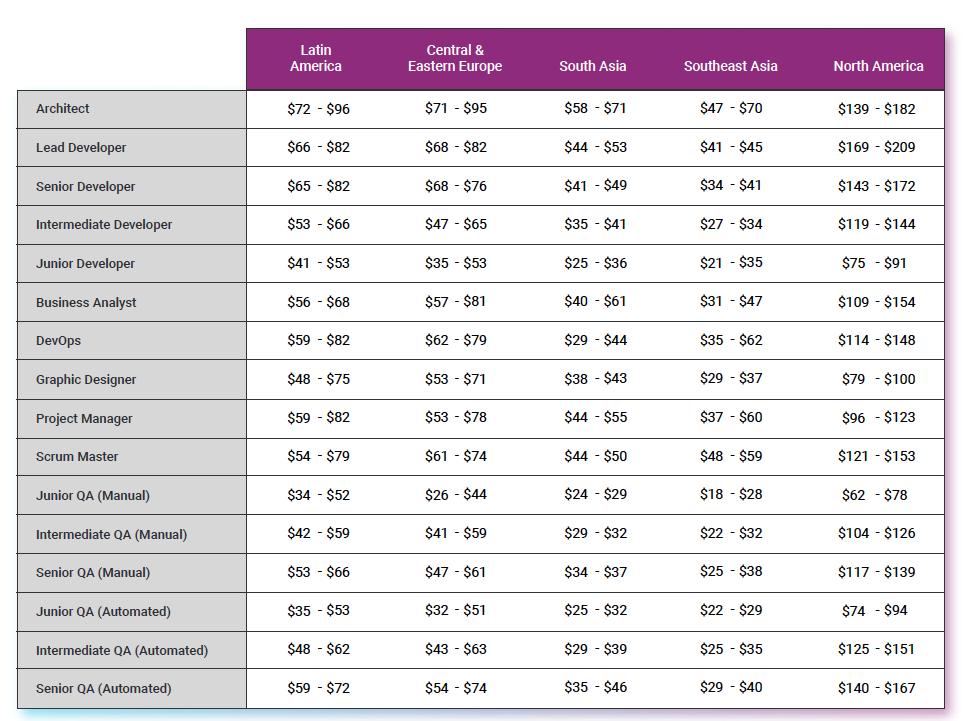
What is IT Outsourcing?
IT outsourcing is the practice of hiring a third-party company or individual to perform IT-related functions that are typically performed in-house. These functions can include software development, application maintenance and support, web development, and database management, among others.
Major Benefits of IT Outsourcing
There are many reasons why companies outsource IT functions. Some of the most significant benefits of outsourcing include access to a broader talent pool, cost savings, and increased efficiency. Other reasons include the ability to tap into expertise that may not be available in-house, the ability to focus on core business functions, and the ability to scale up or down as needed.
Forms of Outsourcing
There are several forms of outsourcing. We will discuss offshore, nearshore, onshore, and multisourcing types of outsourcing
Nearshore Outsourcing
In nearshore outsourcing, a business hires a service provider from a neighboring country or region, such as Canada or Mexico for businesses in the United States. The primary benefit of nearshore outsourcing is that businesses can benefit from the lower costs of outsourcing while still maintaining a relatively similar time zone, language, and cultural environment.
Onshore Outsourcing
Onshore outsourcing is a business strategy that involves contracting a service provider within the same country. This service provider can either be a specialized outsourcing company or a freelance professional based locally. Onshore outsourcing typically carries higher costs compared to offshore or nearshore outsourcing.
Multisourcing/Multishore Outsourcing
It’s when a business hires multiple service providers from different locations to handle various tasks or projects. This approach enables the business to benefit from the strengths of various providers and reduces the risk of depending solely on one provider. Multisourcing can combine various forms of outsourcing like offshore, onshore, etc. In conclusion, outsourcing can take different forms based on the geography of the workforce. Companies must evaluate the advantages and disadvantages of each model to find the ideal balance between costs, quality, and service delivery.

Models of outsourcing
Staff Augmentation
Staff augmentation is a model where a company hires additional staff to augment their existing team for short-term or long-term projects. The outsourcing company is responsible for finding qualified candidates, screening them, and providing them with the necessary training to integrate into the client’s team. The client company maintains control over the project, while the outsourcing company manages the staff. Augmented staff can work either onsite or remotely, depending on client preferences.
Project Based Outsourcing
Project-based outsourcing is a model where a company outsources an entire project or a portion of it, with the outsourcing company taking full responsibility for the project’s execution. This type of outsourcing often involves a fixed contract, payment structure, and timeline. The outsourcing company provides a team of experts to complete the project, including project managers, designers, developers, and quality assurance testers. After completion of the project, the outsourcing company hands over the finished product to the client, who assumes all ongoing maintenance.
Dedicated Development Center
The Dedicated Development Center (DDC) model is a business strategy where companies establish a team of dedicated developers either offshore or onshore to work on their software products. In this model, the outsourcing company provides a team of professionals to work exclusively with the client, who maintains complete control over the development process. The DDC model offers greater transparency, flexibility, and cost-savings compared to building an in-house team. The outsourcing company provides infrastructure, equipment, and necessary support to manage the team effectively. This model is suitable for long-term software development projects, offering clients the option to scale up or down as required.
In contrast, the Project-based outsourcing model involves outsourcing either an entire project or a portion of it, with the outsourcing company taking full accountability for executing the project. This type of outsourcing typically includes a fixed contract, payment structure, and timeline, with the outsourcing company assembling a team of professionals, including project managers, designers, developers, and quality assurance testers, to deliver the project. Upon completion, the outsourcing company delivers the finished product to the client, who is responsible for ongoing maintenance.
What are the Most Usually Outsourced IT Services?
Help Desk Support
Help desk support is one of the most common IT services that businesses outsource. It involves providing technical assistance to end-users when they encounter issues with their software or hardware. Outsourcing help desk support can provide businesses with access to 24/7 support, reduce response times, and save costs associated with hiring and training in-house staff.
Network and Infrastructure Management
Outsourcing network and infrastructure management is the delegation of managing and maintaining an organization’s IT infrastructure, which includes servers, routers, and switches, to a third-party service provider. This service is essential for businesses looking to improve their network performance, minimize downtime, and safeguard data security. By partnering with a reputable service provider, companies can focus on their core competencies and strategic goals while leaving the technical aspects of network and infrastructure management to a specialized team. This can lead to significant cost savings, improved efficiency, and enhanced reliability, as the service provider has the necessary tools and expertise to ensure optimal performance and security of the network and infrastructure. Outsourcing network and infrastructure management also provides access to the latest technologies without significant investments in IT resources and training, enabling organizations to achieve their objectives more effectively and efficiently.
Application Development
Application development refers to the process of designing, developing, and maintaining custom software applications. Outsourcing this service is a strategic move for businesses looking to access specialized skills, reduce development costs, and accelerate the time to market for their software products. By partnering with an expert service provider, companies can leverage their technical proficiency and experience to ensure that their software applications are developed with precision and efficiency. This results in significant cost savings, improved quality, and faster delivery times. Outsourcing application development also enables organizations to focus on their core competencies and strategic goals while leaving the technical aspects to a specialized team. In conclusion, outsourcing application development is an essential service that can help businesses improve their software development process, access specialized skills, and speed up the time to market for their software products.
Cloud Computing Services
This type involves the deployment and management of cloud-based IT resources, such as servers, storage, and applications. Outsourcing cloud computing services can provide businesses with access to scalable and cost-effective IT resources, improve business agility, and reduce the burden of managing IT infrastructure.
Cybersecurity Services
Outsourcing cybersecurity services is essential for businesses to protect their IT assets from cyber threats such as hacking, malware, and phishing. This service provides access to specialized skills, resulting in improved threat detection and response times while reducing the risk of data breaches.
Data Analytics and Business Intelligence Services
Outsourcing data analysis services enhances business decision-making through specialized skills in data collection, analysis, and interpretation. This service improves accuracy and speed while reducing costs associated with hiring and training in-house staff.
Web design and development
Web design and development services are often outsourced to specialized service providers. Outsourcing web design and development services can help companies create and maintain a professional and effective online presence without the added costs of hiring and maintaining an in-house team. Service providers can provide companies with access to specialized expertise and technologies, including website design, development, and maintenance.
Mobile app development
Mobile app development is another commonly outsourced IT service. Developing a mobile app can be complex and time-consuming, and may require specialized expertise and technologies. Outsourcing mobile app development can help companies reduce costs and increase efficiency by leveraging the expertise of service providers. Service providers can provide companies with access to specialized expertise and technologies, including mobile app design, development, and testing.
Quality assurance and testing
Quality assurance and testing are essential for ensuring the functionality, reliability, and security of IT systems and applications. Outsourcing quality assurance and testing services can help companies reduce costs and increase efficiency by leveraging the expertise of service providers. Service providers can provide companies with access to specialized expertise and technologies, including testing and quality assurance methodologies, tools, and techniques.
IT project management and consulting
IT project management and consulting services are often outsourced to specialized service providers. Outsourcing IT project management and consulting services can help companies manage complex IT projects and initiatives without the added costs of hiring and maintaining an in-house team. Service providers can provide companies with access to specialized expertise and technologies,

In-House Development vs Offshore Outsourcing: Real Cost Comparison
Before deciding to outsource, it is important to conduct a real software development cost comparison between in-house development and offshore outsourcing. Let’s explore the real costs of in-house development vs offshore outsourcing.
In-House Development Costs
When it comes to in-house development, there are several costs that must be considered. First and foremost, companies must hire and maintain a team of developers, which can be a significant expense. In addition to salaries, companies must also pay for employee benefits, such as healthcare and retirement plans.
In-house development also requires companies to invest in IT infrastructure, including hardware, software, and office space. These costs can quickly add up, especially for companies that need to purchase specialized equipment or software.
Another cost to consider is the time it takes to develop software. In-house development projects can take months or even years to complete, which can result in significant opportunity costs for the company.
Offshore Outsourcing Costs
Offshore outsourcing can provide significant cost savings for companies, but it is important to carefully consider all of the costs involved. When outsourcing, companies must pay for the services of the offshore provider, which can include hourly rates, project fees, and other costs.
In addition to the cost of the services themselves, companies must also consider the cost of managing the outsourcing relationship. This includes time spent communicating with the offshore provider, monitoring the progress of the project, and resolving any issues that arise.
Offshore outsourcing may also require companies to invest in additional IT infrastructure, such as secure communication systems or software to facilitate collaboration between the in-house team and the offshore provider.
Real Cost Comparison
To conduct a real cost comparison between in-house development and offshore outsourcing, it is important to consider all of the costs involved. In some cases, outsourcing may provide significant cost savings, especially for companies that need to develop complex software or need access to specialized expertise. However, in other cases, in-house development may be more cost-effective, especially for smaller projects or projects that require close collaboration between the in-house team and the offshore provider.
In addition to cost considerations, companies must also consider other factors, such as the quality of the services provided, the security of their data, and the potential risks associated with outsourcing.

IT Outsourcing Risks and Major challenges
IT outsourcing can help businesses take advantage of cost-effective, quality IT services. However, there are also several risks and challenges associated with IT outsourcing that businesses should be aware of.
Communication Barrier
One of the biggest risks associated with IT outsourcing is the communication barrier that can exist between the company and the outsourced service provider. Language barriers, cultural differences, and time zone differences can all contribute to miscommunications and misunderstandings. This can lead to delays, errors, and quality issues, as well as damage to the relationship between the company and the service provider.
Quality That Doesn’t Match Standards
Another risk associated with IT outsourcing is the potential for quality issues. Companies may outsource IT services in order to access specialized expertise or to reduce costs, but if the quality of the services provided does not match the company’s standards, then the outsourcing relationship can quickly become a liability. Quality issues can arise due to a variety of factors, including miscommunications, lack of expertise, or poor project management.
Time Zone Differences
Time zone differences can also present a challenge when outsourcing IT services. If the company and the service provider are located in different time zones, it can be difficult to coordinate schedules and communicate in real time. This can lead to delays in project completion and can make it difficult to resolve issues quickly.
Compliance Issues
Finally, outsourcing IT services can also present compliance issues. Depending on the nature of the services being outsourced, companies may be required to comply with certain regulations and standards, such as HIPAA or GDPR. If the outsourced service provider does not comply with these regulations, it can result in legal and financial liabilities for the company.
To mitigate IT outsourcing risks, companies should carefully vet potential service providers, establish clear communication protocols, and closely monitor the quality of the services provided. With careful planning and management, outsourcing IT services can be a valuable tool for companies looking to reduce costs and access specialized expertise.
Factors that Define Outsourcing Rates
When it comes to outsourcing rates, many factors come into play. Let’s explore the factors that define outsourcing rates.
Length of the Project
The length of the project is one of the primary factors that determine outsourcing rates. Longer projects typically require more resources and time commitments from the outsourced service provider, which can drive up the cost of the project. Shorter projects, on the other hand, can be completed more quickly and efficiently, and may therefore be less expensive.
Scope of Projects
The scope of the project is another important factor in determining outsourcing rates. Projects with a broader scope typically require more resources and expertise, which can drive up costs. More specific or narrowly defined projects, on the other hand, can be completed more quickly and efficiently, and may therefore be less expensive.
Size of the Team
The size of the team required to complete the project is also a significant factor in outsourcing rates. Larger teams require more resources, including staff and infrastructure, which can increase the overall cost of the project.
QA Included or Not
Quality assurance (QA) is another factor that can impact outsourcing rates. If the outsourced service provider includes QA as part of their services, it can increase the overall cost of the project. However, it can also ensure higher-quality work and reduce the likelihood of costly errors.
Level of Expertise
The level of expertise required to complete the project is also a key factor in determining outsourcing rates. Projects that require highly specialized expertise, such as in artificial intelligence or machine learning, can be more expensive to outsource.
Infrastructure
Infrastructure is another important factor that can impact outsourcing rates. The cost of hardware, software, and other infrastructure needed to complete the project can drive up the overall cost of outsourcing.
Communication
Effective communication between the company and the outsourced service provider is critical to the success of the project. Poor communication can lead to misunderstandings and errors, which can drive up costs. Therefore, the quality and frequency of communication should also be considered when determining outsourcing rates.
Understanding these factors can help companies make informed decisions when choosing an outsourcing partner and negotiate outsourcing rates that are both fair and competitive.

Best IT Outsourcing Destinations
One of the most significant factors in outsourcing IT services is the cost, which is typically lower than hiring local IT professionals. However, outsourcing rates can vary greatly depending on the region and the specific services needed.
It’s essential for businesses to understand the current IT outsourcing rates per region to make informed decisions about outsourcing services. Let’s take a closer look at the outsourcing rates in different regions around the world.
IT Outsourcing Rates per region in Y2023
Central, Western, and Northern Europe
Central, Western, and Northern Europe are known for their high standards of living and advanced economies, making it an ideal region for outsourcing IT services. However, the cost of outsourcing in this region is relatively high compared to other regions. The average hourly rate for IT outsourcing in this region is around $80-$120, depending on the specific services needed.
Eastern Europe
Eastern Europe has become a popular outsourcing destination due to its well-educated workforce, lower cost of living, and convenient location. The hourly rates for IT outsourcing in Eastern Europe are generally lower than in Central, Western, and Northern Europe, with an average of $35-$55 per hour. Eastern Europe has a convenient time zone, which can be an advantage for businesses that require 24/7 technical support. Moreover, the region has a good level of IT infrastructure and a robust security system, which can be essential for businesses that require data security.
Asian Region (Asia and the Middle East)
The Asian region, including countries such as India, China, and the Philippines, is known for its competitive IT outsourcing rates. The region has a large pool of talented IT professionals, which keeps the cost of outsourcing services low. The average hourly rate for IT outsourcing in the Asian region is around $20-$40 per hour, making it an attractive destination for companies looking to reduce costs.
Latin America
Latin America is becoming an increasingly popular outsourcing destination due to its proximity to North America, cultural similarities, and relatively low costs. The hourly rates for outsourcing software development to Brazil are similar to those in Eastern Europe, with an average of $35-$55 per hour.
Businesses should consider their specific needs and requirements when choosing an outsourcing destination. They should also evaluate the quality of services, communication, cultural fit, and security measures in addition to the cost of outsourcing services. By doing so, they can make an informed decision and choose the best outsourcing destination for their business.

Criteria to Determine when Choosing an Outsourcing Destination for Software Development
When it comes to outsourcing software development, choosing the right destination is crucial to ensure success. There are several factors to consider when selecting an outsourcing destination, including the innovation ecosystem and ICT sector, technology expertise and talent pool, education and science, business environment, economic and political factors, language skills, cultural similarity, time and location, and software development rates.
The innovation ecosystem and ICT sector
The innovation ecosystem and ICT sector play a significant role in determining the outsourcing destination. The destination’s innovation ecosystem and ICT sector should be robust and constantly evolving. The presence of technology parks, incubators, and accelerators can signify a strong innovation ecosystem. The country should also have a strong ICT infrastructure and technological advancements to support software development. Therefore, it is essential to select a country with a robust innovation ecosystem and ICT sector for outsourcing software development.
The technology expertise and talent pool
The technology expertise and talent pool of the outsourcing destination is also crucial. The country should have a strong pool of skilled developers who can deliver quality software development services. The technical expertise of the developers should be in line with the project requirements. A strong talent pool ensures that the project is completed on time and within budget, while maintaining high quality.
Education and Science
The quality of software development services offered by an outsourcing destination is significantly influenced by the state of education and science in the country. A robust education system that produces skilled professionals in technology is essential for the success of software development services. The presence of research institutions and universities signals a strong education and science ecosystem, demonstrating the country’s commitment to technology advancement. As such, businesses seeking to outsource software development services should prioritize destinations with a strong focus on education and science.
The Business Environment
The business environment of the outsourcing destination is also essential. The country should have a friendly business environment that encourages entrepreneurship and innovation. The presence of supportive government policies and tax incentives can indicate a favorable business environment.
Economic and political factors
Economic and political factors can significantly impact the outsourcing destination. The country’s economic stability, political stability, and legal framework should be considered when choosing a destination. A stable economic and political environment ensures continuity of the project and protects the intellectual property rights of the client.
Language skills
Language skills are crucial when outsourcing software development. The destination country should have a significant number of professionals who are proficient in the client’s preferred language. This ensures effective communication between the client and the development team, which is crucial for the success of the project.
Cultural similarity
For outsourcing to be successful, cultural similarity is a vital consideration. The destination country should share a similar culture to the client’s, promoting effective communication and understanding of the client’s requirements. This cultural alignment enables the development team to deliver services that meet the client’s expectations and fosters a productive working relationship. Therefore, businesses seeking to outsource should carefully evaluate potential destinations to ensure that their cultural environment is a good match.
Time and location
Effective outsourcing requires consideration of various factors, including time and location. Choosing a destination country in a convenient time zone for the client and with good connectivity is crucial to ensure effective communication and timely delivery of projects. The location should also be easily accessible to facilitate regular communication and collaboration between the outsourcing team and the client. Proper consideration of time and location factors can help to ensure outsourcing success and achieve project goals efficiently.
Software development rates
Finally, software development rates are a crucial factor to consider when selecting an outsourcing destination. The rates should be competitive, and the quality of services should be maintained. Therefore, it is essential to choose a destination with reasonable software development rates.

4 East European Unique Destinations for Offshore Software Development: Czech Republic, Moldova, Poland, and Armenia
In recent years, Eastern Europe has become a hub for offshore software development, attracting businesses from around the world. With its skilled workforce, lower cost of living, and favorable business climate, the region offers a compelling alternative to other outsourcing destinations. Among the many countries in the region, the Czech Republic, Moldova, Poland, and Armenia stand out as unique and promising destinations for offshore software development.
Czech Republic
The Czech Republic has a well-established and thriving technology industry, with a high concentration of tech startups and established companies in Prague and other cities. The country has a skilled workforce with a strong engineering and technical background, making it an attractive destination for software development. Additionally, the country has a favorable business climate, with low corporate taxes and a stable political environment.
Moldova
Moldova is a hidden gem in Eastern Europe, offering a cost-effective and skilled workforce for software development. The country has a strong educational system, producing a large number of IT graduates each year. Furthermore, the country has a low cost of living, making it an affordable destination for businesses looking to outsource software development. Moldova also has a favorable business climate, with a simplified taxation system and a growing startup ecosystem.
Poland
Poland has become a popular destination for offshore software development in recent years, thanks to its large pool of highly skilled IT professionals. The country is home to many established software development companies, as well as a growing number of tech startups. Poland has a favorable business climate, with low taxes and a supportive government. Additionally, the country has a strategic location in the heart of Europe, making it easily accessible to businesses across the continent.
Armenia
Armenia is an up-and-coming destination for offshore software development, with a highly educated workforce and a growing technology sector. The country has a strong tradition of science and engineering, with a large number of IT graduates each year. Additionally, Armenia has a favorable business climate, with low taxes and a supportive government. The country is also home to a growing number of tech startups, creating a vibrant ecosystem for software development.
Eastern Europe offers a range of unique and promising destinations for offshore software development. The Czech Republic, Moldova, Poland, and Armenia are just a few of the countries in the region that stand out for their skilled workforce, favorable business climate, and strategic location. By partnering with a reputable software development company in one of these countries, businesses can access high-quality software development services at a lower cost, while also benefiting from the expertise and innovation of these dynamic and growing tech ecosystems.
Comparing Software Development Hourly Rates in Eastern European Countries
Country | Junior Developer | Mid-Level Developer | Senior Developer |
Ukraine | $10-$25 | $25-$45 | $45-$80 |
Poland | $20-$40 | $40-$70 | $70-$120 |
Romania | $10-$25 | $25-$40 | $40-$80 |
Bulgaria | $10-$25 | $25-$45 | $45-$80 |
Hungary | $10-$25 | $25-$45 | $45-$80 |
Czech Republic | $15-$35 | $35-$60 | $60-$100 |
Estonia | $15-$30 | $30-$60 | $60-$90 |
Latvia | $10-$25 | $25-$45 | $45-$80 |
Armenia | $10-$25 | $25-$40 | $40-$75 |
It’s important to note that these rates are just a general guide and can vary depending on the specific project requirements, level of expertise, and other factors. However, overall, Eastern European countries offer competitive rates compared to other outsourcing destinations, while still providing high-quality software development services. Additionally, the region offers a skilled workforce, favorable business climate, and strategic location, making it an attractive destination for businesses looking to outsource their software development.
Why choose Armenia to Outsource Software Development
In recent years, Armenia has become an increasingly popular destination for outsourcing software development. Located in the heart of the Caucasus region, Armenia offers a unique blend of skilled talent, favorable business environment, and cultural diversity, making it an attractive option for businesses looking to outsource their software development needs. In this article, we’ll explore some of the reasons why you should consider choosing Armenia as your outsourcing destination.
Education
Armenia has a strong tradition of education, with a literacy rate of over 99%. The country boasts a number of prestigious universities, including the Yerevan State University, the Armenian National Agrarian University, and the American University of Armenia. These institutions produce a steady stream of highly skilled graduates, many of whom go on to work in the technology sector.
Language Skills
One of the key advantages of outsourcing to Armenia is the country’s multilingual workforce. The official language of Armenia is Armenian, but many Armenians are also fluent in Russian and English. This makes communication with software developers in Armenia much easier and more efficient than with developers in some other outsourcing destinations. In addition to being multilingual, Armenians are also highly proficient in English. In fact, English is the most widely spoken foreign language in Armenia, with many Armenians having received their education in English. This makes communication with clients in English much easier and ensures that there are no misunderstandings or communication barriers between the development team and the client.
Time Zone
Another advantage of outsourcing to Armenia is the time difference. Armenia is located in the GMT+4 time zone, which means that it is 4 hours ahead of Coordinated Universal Time (UTC+0). This time difference can be very beneficial for businesses in Europe and the United States, as it allows for 24-hour development cycles and ensures that work is completed faster and more efficiently.
Diversity and Tolerance in Armenia
Armenia is a diverse and tolerant country that welcomes people from all over the world. The country has a rich cultural heritage, and its people are known for their hospitality and openness to new ideas. This makes Armenia an attractive destination for businesses that are looking to work with a diverse and tolerant workforce.
Business Environment
Armenia has a favorable business environment that is conducive to entrepreneurship and innovation. The government of Armenia has implemented a number of measures to support the growth of the tech sector, including tax breaks and other incentives for tech companies. The country also has a strong legal system and a business-friendly regulatory environment, which makes it easy for companies to set up and operate in Armenia.

Armenia as a Tech Hub
Armenia has a vibrant and rapidly growing tech environment that is attracting the attention of businesses and investors from around the world. With a highly skilled and talented workforce, Armenia is quickly becoming a hub for innovation and technology.
The ICT sector in Armenia is one of the fastest-growing industries in the country. The government of Armenia has made a significant investment in the sector, and this has led to the development of a strong and dynamic ecosystem of tech companies.
Armath Laboratories
Armath Laboratories is a unique program that was developed in Armenia to promote
STEM education and innovation. The program provides students with the opportunity to learn coding and robotics, and it has been very successful in promoting innovation and entrepreneurship among young people in Armenia.
TUMO centers for Creative Technologies
TUMO is a network of learning centers that was developed in Armenia to promote creativity and innovation among young people. The centers provide students with access to state-of-the-art technology and resources, and they have been very successful in promoting innovation and entrepreneurship in Armenia.
How Many Software Developers are There in Armenia?
Armenia has a rapidly growing tech industry, with more than 20,000 IT professionals working in the country. The government of Armenia has made a significant investment in the tech sector, and this has led to a surge in the number of software developers in the country.
What are the Top Programming Languages in Armenia?
The most popular programming languages in Armenia are Java, Python, C++, and JavaScript. These languages are widely used by software developers in Armenia and are in high demand by companies looking to outsource their software development needs.
Growing Community of Tech Best Companies
Armenia is fast becoming a hub for international brands, thanks to its thriving IT economy. The country is home to several highly respected companies, including Picsart, a mobile photo editing app with over 150 million active users. This app alone employs more than 350 people in Armenia, highlighting the country’s strong pool of tech talent.
One of the world’s leading technology companies, NVIDIA, has also recognized Armenia’s potential and established a physical presence in the country. With an annual revenue of $27 billion and a workforce of over 20,000, NVIDIA’s Armenian branch is led by Rev Lebaredian, Vice President of Omniverse and Simulation Technologies.
Another major IT employer in Armenia is Synopsys Armenia, which conducts research and development while offering product support for semiconductor IP solutions, design for manufacturing solutions, and electronic design automation (EDA) tools. With over 850 employees, the company is a significant player in the Armenian tech industry. Synopsys Armenia has three offices in the country, including two in Yerevan and one in Gyumri, making it a prominent outpost for the company.
Armenia’s growing IT economy and the presence of such renowned international brands highlight the country’s potential for software development outsourcing partnerships. At DevelopWay, we have a deep understanding of the Armenian IT industry and the talent that drives it. Contact us today to explore how our software development services can help your business succeed in the digital age.
IT Startup Ecosystem in the Republic of Armenia
Armenia’s IT industry has also spawned a thriving startup culture, with numerous startups emerging in recent years and attracting venture capital funding from around the world. The ecosystem is supported by leading technology incubators and accelerators, such as the Enterprise Incubator Foundation, Armenian National Engineering Labs (ANEL), the ISTC Innovative Solutions and Technologies Center, UITE Innovative Center, Epic Incubator, SmartGateVC and ImpactAim Accelerator.
One of the most notable startups is SoloLearn, a mobile learning platform that teaches coding and computer science to beginners. Since its launch in 2014, SoloLearn has attracted over 21 million users worldwide and raised $5.6 million in funding. The company’s success is indicative of Armenia’s talented pool of software developers and engineers, who are behind many of the country’s most successful startups.
PicsArt: As mentioned earlier, PicsArt is a popular mobile photo editing app with over 150 million active users. The company has raised $45 million in funding and is headquartered in San Francisco, with a major office in Yerevan, Armenia.
Krisp: An AI-powered noise cancelling app that mutes background noise during calls. Krisp has raised $65 million in funding and counts companies such as Hubspot and GitLab among its clients.
Renderforest: A platform that allows users to create professional-quality videos, animations, and websites without any technical skills. Renderforest has over 10 million users and has raised $7 million in funding.
Chessify: A mobile app that uses computer vision to analyze chess positions and provide users with optimal moves. Chessify has over 1 million downloads and has raised $560,000 in funding.
CodeSignal: A platform for technical assessment and interview management that helps companies hire top software engineers. CodeSignal has raised $87.5 million in funding to date and boasts clients such as Dropbox and Robinhood.
In conclusion, Armenia is an excellent outsourcing destination for businesses looking for high-quality software development services. With a skilled workforce, favorable business environment, and cultural diversity, Armenia has everything that businesses need to succeed in today’s fast-paced global economy. So if you’re looking for a reliable and cost-effective outsourcing partner, consider choosing Armenia for your software development needs.

Thank you for reading our article. We hope you found it informative and helpful in your search for a software development outsourcing partner.
At DevelopWay, we are a team of experienced software developers specialized in providing high-quality software development services to businesses of all sizes and across a variety of industries.
Link: https://developway.org/it-consulting-and-software-development-company-in-armenia/
If you are looking for a reliable software development outsourcing partner, we would be happy to discuss how we can help your business achieve its goals. Contact us today to learn more about our services and how we can assist you in your software development needs!



